Legend says that the “Maker of everything,” god Wiracocha, created the world and everything that lives in it. The pre-Inca culture Tiahuanaco bequeathed this unseen deity to the Incas.
But, over time, the Incas began to place more importance on a visible God. Who accompanied them daily during sowing and harvesting and warmed them. Illuminated them in their daily chores and fecundated the earth to give its fruits to man, the Sun god. The Sun festival, known as Inti Raymi, was a significant celebration in Cusco during the Inca times.
We collaborated with Machu Travel Peru to create a short article about the history and significance of the Sun Festival. Learn how to navigate this celebration without getting lost.
Everything you need to know about the festival
The Inti Raymi
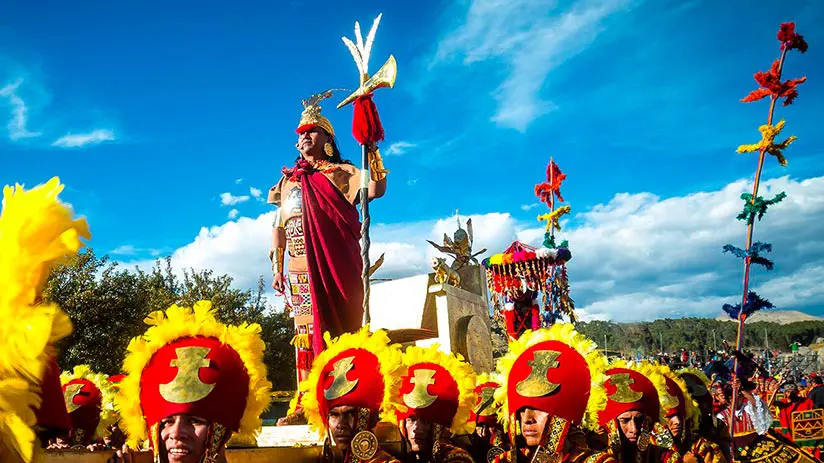
The Inti Raymi consisted of rituals, dances, offerings, animals, and even humans sacrificed in honor of the Sun. The Sapa Inca (emperor) used to direct the festivity from on stage at the Huakaypata center, the current Cusco main square. From there, he used to drink Chicha de Jora before his entourage in the middle of music and dance.
While a priest lit a flame inside the Qoricancha, or the temple of the sun (two blocks from Huacaypata), the women and men dressed in their best clothes and painted their faces yellow.
Animal and human sacrifices
Returning to Huacaypata, the priests used to sacrifice a black llama and opened its chest raw to remove its heart. After, they analyzed it to determine if the coming year would be fruitful or drought. Then, they burned the heart in honor of the Sun god. While the music and dances around them continued.
However, they could make human sacrifices if the future was not prosperous. Those sentenced were children from the 4 Suyos, west, east, south, and north of Cusco.
After the festival, the Inca and his family walked back to the palace. Their path was covered in rose petals, laid out by the Ajllas, virgins devoted to the Sun.
When was it celebrated?
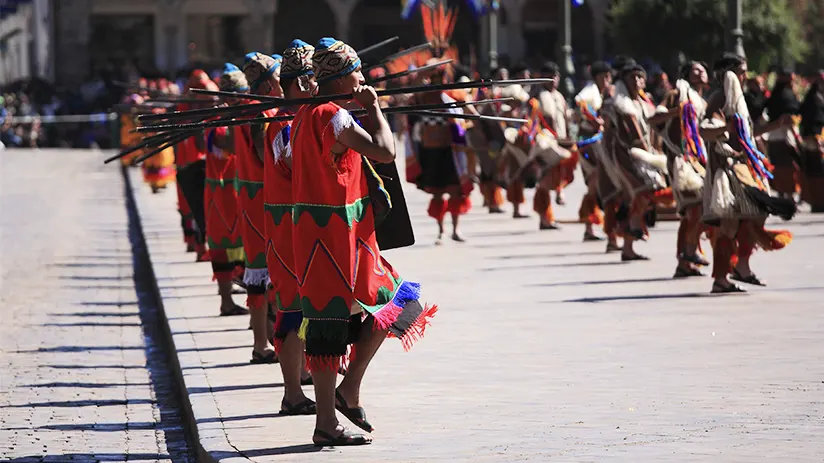
The Incas celebrated Inti Raymi during the southern hemisphere’s winter solstice (June 24). When the sun was farthest from the earth, and the day was the shortest of all year.
For this reason, they chose June 24 to call back their luminous god, the Sun, and thus become closer to him. They also asked for a new year with successful harvests and production: more rain, sun rays, and an abundance of grain for sowing. For this reason, they considered June 24 the first of a new Andean year in the Inca calendar.
Although the winter solstice begins on June 21, according to the Inca belief, the Sun wasn’t moving from its place until June 24. The festivity used to last 9 days. But three days before, all the participants went through fasting, only eating white corn and a herb called Chucam.
During this period, the Incas celebrated with music, colorful dances, processions, and even sacrifices in the Qoricancha (the Sun temple). Many of these sacrifices were to ensure good harvests for the year. In addition to giving thanks to the Pachamama (Mother Earth) and paying tribute to the firstborn of the Sun, the Inca.
History
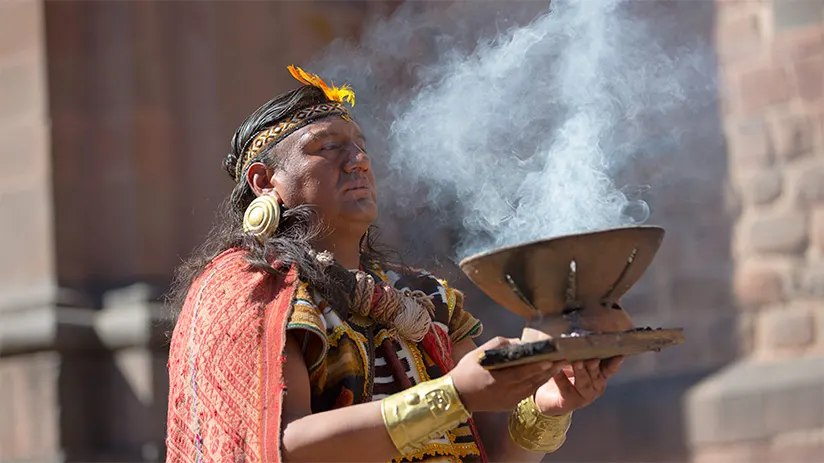
1. Inca period
Pachacutec (1400 – 1471) was the most critical emperor among the Inca rulers. He was a great conqueror who expanded the Inca territory in multiple directions from Cusco.
He also oversaw the construction of Machu Picchu and was dedicated to ceremonies and rituals for the Sun deity. Therefore, he ordered the first celebration on June 24, 1412 (Inti means sun, and Raymi means celebration). In this sense, he created a critical Inca tradition.
It was followed by successive rulers until the last one, Atahualpa Inca, in 1535, one year before the entry of Spanish conquerors to Cusco.
2. Colonial times
When the Europeans invaded the capital of the Inca Empire (1536), the Catholic priests immediately prohibited the ceremony. They claimed that it was pagan and tried to impose the foreign Catholic religion as quickly as possible on a population accustomed to worshiping nature deities.
For this reason, the Incas celebrated the Sun festivity secretly, in little groups, hidden from the Spanish authorities. This continued until 1572 when the Spanish Viceroy Francisco de Toledo forbade festivity, traditional Inca clothing, and religion. He replaced it with a festivity in honor of Saint John the Baptist.
Of course, Francisco de Toledo had reasons to prohibit the festivity, at least after the rebellion of the Inca leader Tupac Amaru I (the festivity instilled Inca nationalism).
3. Republican age
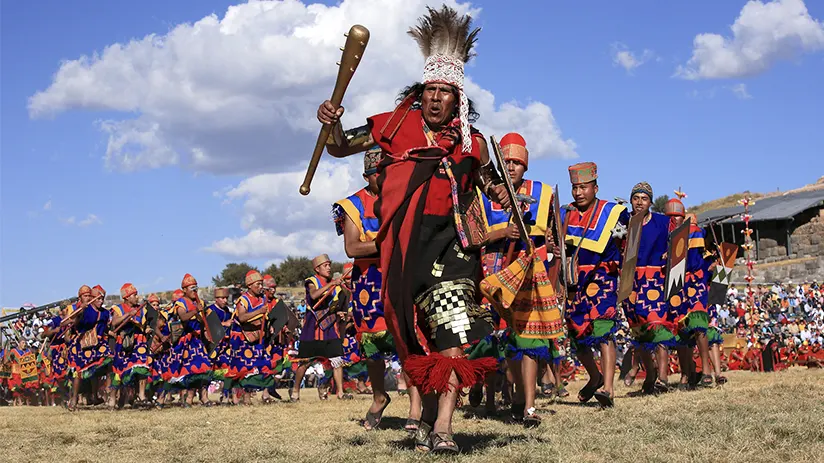
Once Peru obtained its independence and many years later, in 1944, the American Institute of Arts of Cusco, after laborious research work by Cusquenean scholar and playwright Faustino Espinoza Navarro, authorized the celebration and representation of the Inca’s Sun festivity again. The writings of Inca Garcilaso de la Vega (A famous Cusquenean colonial chronic and writer) were the base of this research. Garcilaso de la Vega’s books described the renowned celebration in great detail in the Inca times. In this sense, that year (1944), the first reconstructed ceremony took place.
4. Nowadays
From that date until now, every June 24 of each year, more than 500 actors, dancers, and the general public held a theatrical performance of the Sun Festivity in three critical places of Cusco. The ceremony starts at the Qoricancha, an ancient Sun Temple in Cusco.
The ceremony begins at the Qoricancha, an ancient Sun Temple in Cusco. It then proceeds to the main square, Huacaypata. Finally, it concludes at the Sacsayhuaman Fortress, which is located 2 km away from the main square.
This event tells the stories of the Inca empire, focusing on the impressive performance of the Sapa Inca. Also, the Sapa Inca is carried on golden litter everywhere.
Nowadays, if you visit Cusco on June 24 to see the awesome Inca Sun Festivity, you will be able to appreciate each of these artists in an impeccable representation. Most of the actors and actresses who take part in the dramatization are natives of Cusco. Also, you will hear Andean songs in the ancient Inca language of Qhechua while following the procession among quaint Cusco streets.
In conclusion, you will better understand our beautiful culture, different traditions, and festivals in Cusco. It is an opportunity worth experiencing once in life and definitely one of the best things to do in Cusco.
Inti Raymi today
1. Qoricancha, the Sun temple
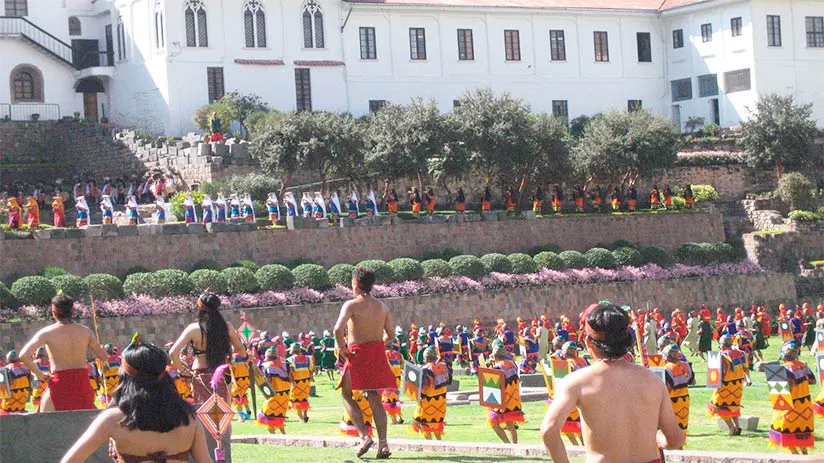
09:00 am (lasts 50 min): Every year, this festivity begins in the exterior gardens of the Qoricancha, an ancient temple of the Sun (Qori means gold, and Cancha means temple). Now, the current Santo Domingo convent.
Musicians, dancers, priests, and Acllas clog their gardens. They all dress in colorful outfits of the Incas’ period style. Some participants even wear animal costumes, like snakes, pumas, and condors. According to Inca mythology, these animals symbolize the underworld, the earthly world, and the celestial world.
At this moment, the Inca recite a prayer to the Sun god. Also, he receives retinues of 4 select children of the 4 Suyos to be sacrificed. (The Suyos were lands of the four sides of Cusco: north, south, west, and east).
The Qoricancha doesn’t have armchairs or reserved seats located around it for viewers or visitors. Therefore, you’ll have to get up early to occupy a good area, bring a portable chair, and see the spectacle without obstacles. The later you arrive, the further behind the crowd you will be.
2. Plaza de Armas (Main square)
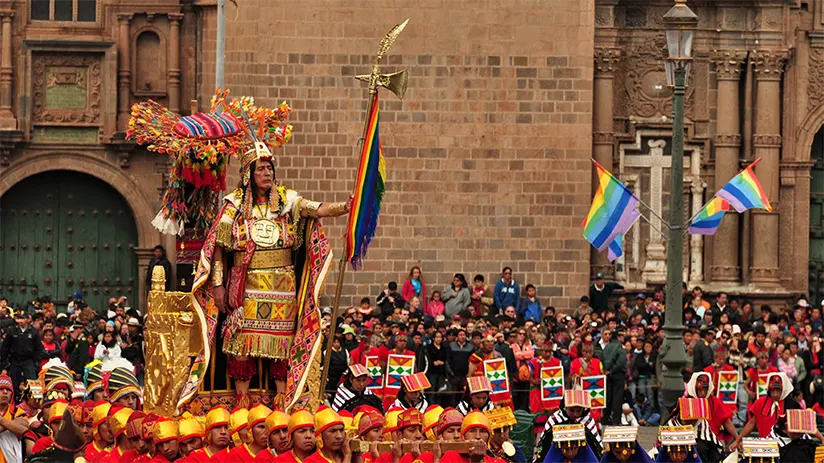
11:00 am (lasts 50 min): Next, the procession moves from Qoricancha to the Cusco Plaza de Armas. Acllas throw flower petals during the transfer. They do this ahead of the Inca litter.
The purpose is to clean the route of evil spirits. This makes it easier for the royal porters to walk. The procession continues by Pampa del Castillo Street and Loreto Street.
Once we arrived at Main Square, we learned that in Inca times, there was a place called Huacaypata, or wailing square, which was used for a special ceremony.
The Inca ruler and priest would stand before the Cusco Cathedral for the ceremony. They would perform a ritual using Coca leaves. This ritual predicted the future harvest and the empire’s well-being. They would perform a ritual using Coca leaves to predict the future harvest and the empire’s well-being.
Try to arrive early and take a good spot in the surrounding areas of the Plaza de Armas (usually, these are stone portals that surround the plaza and shelter many shops and restaurants); there are no reserved chairs.
One way to watch the show is by reserving a table on a balcony at a popular restaurant. The restaurant is located on the second floor of nearby buildings. From there, you can sit, enjoy a drink or meal, and see the spectacle from above. Also, getting there won’t be a problem; most good Hotels in Cusco are close to the main square.
3. Sacsayhuaman
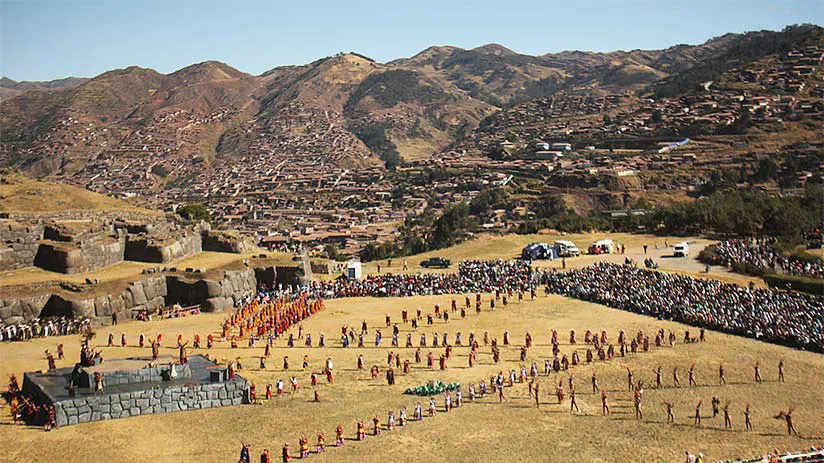
13:00 pm (lasts 90 min): The Inca, its entourage, priest, soldiers, royal porters, Ajllas, and noble people, continue the procession to Sacsayhuaman. This happens once the Coca leaf reading is finished in the main square.
The Sacsayhuaman fortress is located 2 km from Cusco Center. The real show begins with dances, music, and soldier choreography along the gigantic esplanade of Sacsayhuaman, with everyone giving their best. The sovereign, with his wife, the Colla, and his leading priests, see all the spectacle over an atrium made of artificial stones in the esplanade’s center.
After that, the Inca recited a prayer to the Sun god, and the sacrifices began. The first victim was a black llama, and the Inca and its prominent priest extracted the heart from it.
Seeing the spilled blood, they can predict the future of the empire. They sacrifice a child chosen from one of the 4 Suyos if the future is uncertain or bad. In addition, they offered the child’s sacrificed blood to the Sun God. But don’t worry, all these acts are theatrical representations of what happened once a long time ago.
Finally, more dances and music continue until the Inca ends the ceremony. Then, a long procession back to the city of Cusco begins.
At Sacsayhuaman, the Cusco municipality added seats and bleachers around the area where the show is happening. These seats are paid, usually, the prices are in American dollars, and these costs are according to the area of view. The zones are divided into three colors, Orange, Red, and Green. And these usually sell out in 6 months.
Buy festival seats
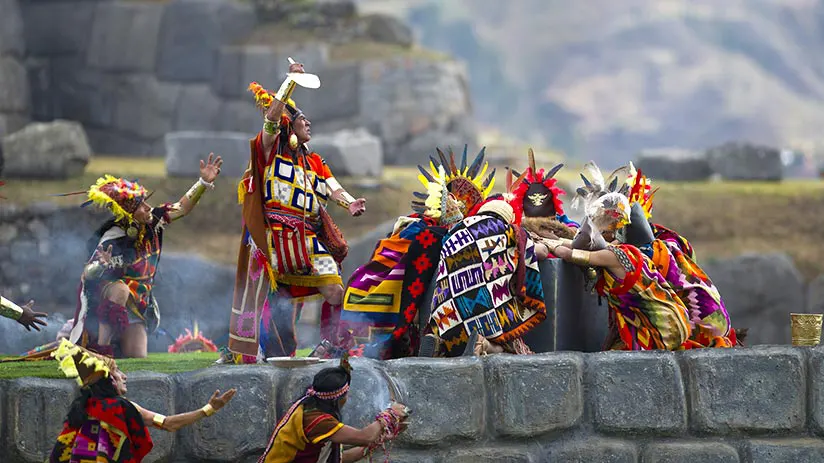
As we mentioned, seats for viewers are well-distributed in Sacsayhuaman. It is maybe one of the most important archaeological sites in Cusco. The visitors need to book those in advance seats if they want to enjoy the famous Inti Raymi in Cusco. Finally, it is essential to mention that this festival is in veneration of the sun god Inti.
A. Green zone
The Green area is usually located almost behind the stage, close to the Sacsayhuaman bastions, therefore, the seats are the cheapest.
- Adult foreign: $100
- Child foreign or national: $40
- National tourist: $50
- Locals (born in Cusco): $40
However, if you don’t want to pay anything, you can go early and get a good space over Suchuna Hill, located in front of the Sacsayhuaman esplanade. The local population sees the spectacle totally free, so you can enjoy this fantastic festivity without paying anything!
B. Red and Orange zones
Instead, the red and orange zones have seats located just in front of the scenery, for this reason, the seats usually are more expensive than the green zone.
- Adult foreign or national: $150
- Child foreign or national: $75
Pay attention. The Cusco municipal celebration company (EMUFEC) makes tickets available 6 months before the event.
Credit cards or bank transfers can be used to purchase tickets.
Tips
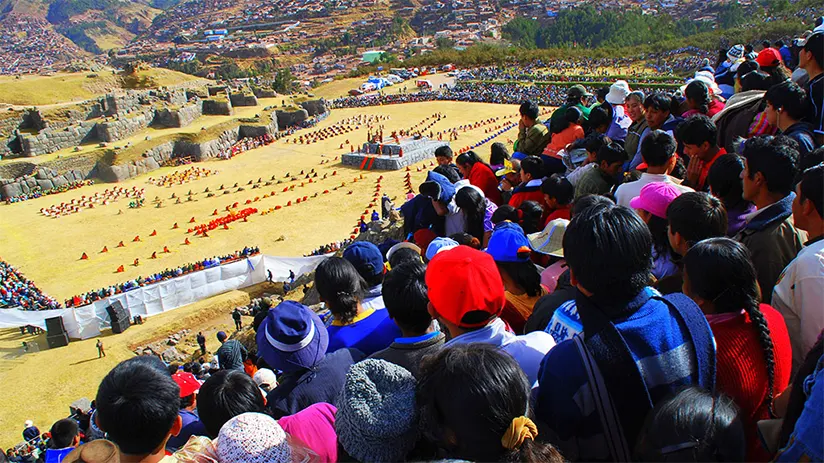
- Book your tickets to assist with part of the festivity located in Sacsayhuaman 6 months in advance through a Cusco City tour. In this form, you’ll easily get your entrance fees, transportation to the Sacsayhuaman, and even a guide translator of Quechua to English. Remember that the ceremony is developed in the Inca’s ancient language, the Quechua.
- Always be alert with your personal belongings. As we told you, in June and especially the week before the festivity, the historic center of Cusco used to be overcrowded with people. Therefore, take care of your personal belongings; pickpockets may be on the prowl. We recommend you carry only phones or cameras, not more iPads, drones, etc.
- In the middle of the dry season, June offers hard rays of sunshine, clear skies, and dry winds. Therefore, it is a great idea to carry sunblock, a hat, and sunglasses.
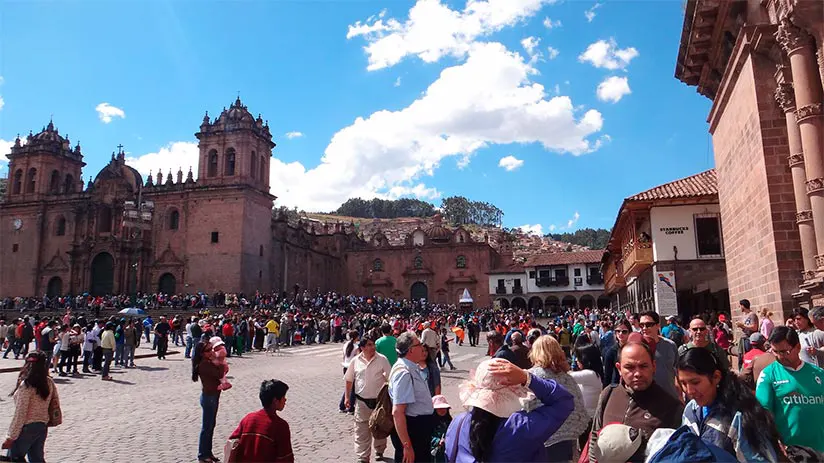
- To avoid insolation, carry bottles of water and drink them slowly. Also, take a small backpack or bag to throw away your waste; Sacsayhuaman only has garbage cans at checkpoints.
- Wear comfortable clothes, like trekking pants and shoes, a T-shirt, a sweatshirt, and a hat. If you have a windbreaker, it will be better.
- If you want to take a walk by the Cusco center during the days of this celebration and enjoy the festivity by yourself, we suggest you get, first, a Cusco tourist map and avoid the crowds.
“THE INTI RAYMI URGES US TO CREATE DELIGHT INSIDE AND TO ENABLE OUR LIVES TO MIRROR OUR INTERNAL BLISS”
As you can see, this celebration is not something to let go unnoticed; June 24 is an emblematic time when Cusco is revitalized, and its colors, traditions, and beautiful legends take shape with this fantastic celebration. Being part of the Inti Raymi, you will be able to understand in greater depth the themes that shape the daily life of Cusco and revalue the cultural heritage. Together with Machu Travel Peru, we hope we have been of help. Consult our advisors if you want to enjoy this celebration on your next vacation. Our team will be excited to help you make the trip of your dreams come true.